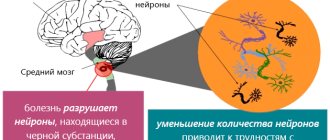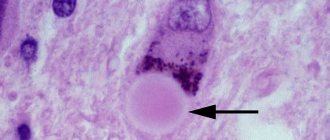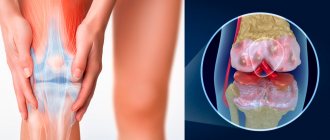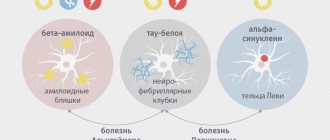Parkinsonism, or Parkinson's disease, is a degenerative disease of the central nervous system, which in most cases results in disability and death.
Parkinson's disease is defined by four characteristic features that make up the tetralogy of parkinsonism:
- shaking (tremor) of the head, limbs,
- muscle stiffness (stiffness),
- limited movement (hypokinesia),
- changes in gait, posture (postural disorders).
Parkinsonism is a common neurological disease, affecting 120–180 people out of 100 thousand, and the disease has a pronounced age dependence.
Our expert in this field:
Lashch Natalia Yurievna
Neurologist of the highest category, candidate of medical sciences, associate professor. Laureate of the Moscow City Prize in the field of medicine.
Call the doctor Reviews about the doctor
Causes
There are two types of Parkinson's disease. The first is true parkinsonism, it accounts for up to 80% of cases of the disease.
The second is parkinsonism syndrome, which accompanies traumatic brain injuries, encephalitis, stroke, and brain tumors.
The exact causes of true parkinsonism, or Parkinson's disease, are unknown.
But several facts have been established:
the disease develops mainly in old age (after 60 years),
degenerative changes begin with the irreversible process of death of neurons in the brain stem,
the development of symptoms of the disease is associated with a lack of dopamine, a neurotransmitter on which signal transmission in interneuron connections depends,
there is a genetic predisposition.
In approximately 15% of cases, Parkinson's disease occurs against the background of a negative family history (presence of the disease in close relatives) and is inherited.
Some factors may influence the development of the disease:
- intoxication (chronic poisoning with chemical toxins in hazardous industries, unfavorable environment, exposure to pesticides, manganese),
- infectious lesions of the central nervous system (encephalitis, etc.),
- traumatic brain injuries,
- impaired functioning of the kidneys and liver.
Causes of the disease
Since the exact causes of the disease have not been established, experts identify a number of factors that contribute to the formation of pathology. These include:
- hereditary predisposition - it has been proven that in 20% of all cases in past generations, the patient’s immediate relatives also suffered from parkinsonism;
- the presence of free radicals in the substantia nigra - such particles cause oxidative processes in the organ, which leads to irreversible damage to the affected areas;
- brain intoxication with internal and external toxins;
- genetic abnormalities - scientists have determined that in the presence of a certain gene, juvenile parkinsonism develops in young people;
- lack of vitamin D in older people increases the risk of brain damage from free radicals and toxic substances;
- the formation of abnormal mitochondria in brain cells, provoking the development of degenerative processes in them;
- infectious and inflammatory lesions of various brain structures - encephalitis, viruses, meningitis, etc.;
- congenital anomalies of vascular structure;
- atherosclerosis;
- severe concussions and head injuries – cause disruptions in the functioning of the substantia nigra;
- use of narcotic drugs and certain medications (for example, antipsychotics);
- alcohol abuse;
- unfavorable environmental situation in the region of residence.
Symptoms
The development of Parkinson's disease is directly related to a lack of dopamine - this is one of the neurotransmitters that ensure the transmission of signals in interneuron connections. That is, the conductivity of nerve fibers.
A lack of dopamine leads to the fact that signals in interneuron connections “freeze”, the speed of their transmission sharply decreases, this leads to impaired motor functions and mental abilities.
This is why Parkinson's disease is always accompanied by both motor and mental impairments.
The first signs of the disease are rarely a cause for concern - stiffness of movement in the right half of the body, twitching (trembling) of the hands, oily skin and hair, frequent depression, constipation.
Over time, pronounced tremor occurs - trembling of the arm, leg, and then the head, involuntary movements of the fingers.
At an early stage, the tremor affects only one arm (leg), and then spreads to the second. Tremors always begin in the limbs, and head tremor joins with the development of the disease.
The person’s movements become slow, the gait is shuffling. He moves in small steps, before turning around, marking time.
The back is bent in an arch, the head is lowered, the arms and legs are bent, and a characteristic stoop is formed - the “petitioner pose.”
Facial expressions are becoming increasingly impoverished. The face becomes motionless and loses expression. The impression arises that the person does not react to anything.
The muscles become less and less mobile, rigid, it becomes difficult for a person to make movements, their volume is increasingly limited. He cannot fasten buttons, tie shoelaces, shave, brush his teeth, and over time he completely loses the ability to take care of himself in everyday life.
Speech changes - it becomes unintelligible, quiet, monotonous.
Over time, the clinical picture is supplemented with new symptoms:
- dementia develops
- impotence occurs,
- urination increases,
- swallowing is impaired,
- the skin becomes dry,
- sweating increases,
- sense of smell worsens,
- sleep is disturbed
- blood pressure decreases,
- salivation increases.
Forms of the disease
The forms of Parkinson's disease are determined depending on which of the symptoms is most severe.
1. Trembling form - trembling (tremor) predominates in the arm, leg or both arms, legs, head, and the most pronounced tremor is at rest. With movement, it may weaken or even disappear.
2. Rigid form – characterized by stiffness in the muscles, especially when starting to move, and limited mobility.
3. Akinetic form - characterized by slowness of movements, impoverishment or complete absence of facial expressions.
Along with these three main forms, mixed forms are distinguished: rigid-tremorous, tremulous-rigid, akinetic-rigid, etc.
Treatment at home
Home therapy for the disease involves the use of several methods in combination: 1. Therapeutic baths - water procedures with the addition of herbs such as thyme, linden, St. John's wort, sage help relieve tremors, muscle spasms and nervous tension. The patient’s well-being improves for a certain period, and sleep normalizes. 2. Exercise therapy – a special set of exercises has been developed for patients with Parkinson’s disease, which is suitable for everyday activities. As a result, coordination of movements improves, a sense of stability appears, and motor functions are normalized. 3. Traditional medicine - helps to cope with unpleasant symptoms and alleviate the patient’s well-being. Traditional methods of treatment include:
- consumption of herbal decoctions, teas and tinctures;
- herbal foot baths;
- healing lotions for limbs.
Non-drug methods of treating motor disorders include physical therapy. The exercises are aimed at training walking, balance, and performing various movements of the limbs. The doctor will tell you and show you what exercises to do. It would be nice to purchase a bicycle ergonometer - a home exercise bike with increased accuracy of settings.
No one is immune from Parkinson's disease, since there are no methods of prevention. If the disease still overtakes you, do not despair. This disease does not shorten life, but simply worsens its quality. If you diagnose the disease at an early stage, follow all the doctor’s recommendations, lead an active and healthy lifestyle, continue to work and remain part of society, you can live a long and happy life.
For more information about Parkinson's disease, watch the video:
This article has been verified by a current qualified physician, Victoria Druzhikina, and can be considered a reliable source of information for site users.
Rate how helpful this article was
4.3 44 people voted, average rating 4.3
Did you like the article? Save it to your wall so you don’t lose it!
Stages
There are five main stages in the development of Parkinson's disease.
At stage 1, trembling appears in only one arm or leg. Usually the disease manifests itself as trembling of the fingers of the right hand.
At stage 2, trembling (tremor) spreads to the second arm (leg). Sleep is disturbed, appetite worsens, excessive salivation occurs, and the chin begins to twitch.
At stage 3, balance is disturbed, body posture changes, the gait becomes shuffling and slow, but the person can still perform ordinary everyday movements and take care of himself. The tremor becomes more and more intensified, speech is impaired, the face becomes emotionless.
At stage 4, changes in gait and body posture become more pronounced. While walking, a person may fall. He can still walk, but can no longer perform simple actions or take care of himself (fasten buttons, hold a spoon). Depression develops.
At stage 5, a person loses the ability to move (walk, stand, sit), coordination of movements is lost. Speech becomes illegible, slurred, swallowing and urination are impaired. Without outside help, his life becomes impossible.
The progression of the disease can be slow, moderate or rapid. In the first case, the transition from one stage to another occurs within five years or longer, in the second case - within 3 - 5 years, in the third case - within two years.
How does parkinsonism occur?
Body movements are controlled by two parts of the nervous system: the pyramidal and extrapyramidal systems. The pyramidal is associated with the regulation of movements, the extrapyramidal is responsible for their fine tuning, coordination, adjustment and accuracy. Violations of the extrapyramidal system lead to various disorders, including: nervous tics, involuntary movements, tremor, chorea, dystonia and others.
The most common disorder is parkinsonism. With parkinsonism, movements slow down and become constrained, and their amplitude decreases. Muscle tone increases, limbs tremble at rest.
Parkinsonism is typical for various pathologies: Parkinson's disease, paralysis, systemic atrophy, hereditary diseases of the nervous system and others. Most cases are related to Parkinson's disease.
Parkinson's disease is a neurodegenerative disease in which neurons in the substantia nigra, a specific area of the brain, die.
The disease mainly manifests itself in people over 50 years of age with a frequency of 150-200 cases per 100 thousand people. There are also earlier forms of pathology.
Parkinsonism leads to a lack of dopamine, which provokes external symptoms such as bradykinesia (slowness of movements), tremor (shaking of the fingers), rigidity (muscle stiffness). To the classic symptoms of the disease are added others, related and unrelated to movements. Gradually the disease progresses. It is important to identify the pathological process in the bud and begin immediate treatment.
Parkinson's disease can be primary or secondary. The primary form is more common and is associated with heredity. Secondary (Parkinson's syndrome) is a condition that manifests itself with characteristic symptoms due to the development of other diseases.
Diagnostics
At the initial appointment, the doctor at the Medica24 International Clinic asks the patient (or his relatives) about the symptoms, the time of their appearance, the dynamics of development, as well as the presence of diseases in the family. This is called taking a personal and family history.
After this, the doctor conducts an external examination, paying attention to violations of coordination, movements, body posture, and uses several tests to assess the degree of rigidity, akinesia (for example, a test for clenching and unclenching a fist, etc.).
When diagnosing, the doctor must differentiate Parkinson's disease from many neurological disorders by the presence of strokes, antipsychotic therapy, the presence of long-term remissions (Parkinson's disease develops without remissions), traumatic brain injuries, a history of encephalitis and a number of other signs.
After establishing a preliminary diagnosis, if Parkinson's disease is suspected, the doctor will refer the patient for additional examinations.
1. Rheoencephalography.
This is a research method using a weak high-frequency electric current that shows the nature of blood circulation in the brain.
2. Electroencephalography.
EEG helps to assess the general and local functional activity of the brain and identify pathological foci.
3. Computed tomography.
A CT scan of the brain gives a detailed picture of blood circulation, the condition of the nervous tissues of the brain, and helps to detect pathological areas and tumors.
4. Magnetic resonance imaging.
MRI of the brain is performed using a magnetic field and, unlike CT, does not expose the brain to radiation. Therefore, this type of examination can be carried out many times. MRI helps to examine in detail the state of the nerve tissue of the brain and detect areas of neuronal damage.
Along with these basic diagnostic methods, laboratory tests are used, and, if necessary, other high-tech, modern examinations, which allow her not only to clarify the diagnosis, but also to determine the best treatment tactics.
Treatment
The main drug treatment for Parkinson's disease is levodopa.
This is a symptomatic remedy that replenishes the lack of dopamine and thus eliminates the main cause of the symptoms of the disease - hypokinesia, tremor, rigidity.
To stimulate the synthesis of dopamine in the brain and increase its level in interneuron synapses, selective MAO-B inhibitors (selegiline), amantadine, piribedil, and pramipexole are used.
In complex therapy of the disease the following are also used:
- antipsychotics (to reduce mental symptoms),
- antispasmodics,
- antidepressants, tranquilizers (to eliminate insomnia, pain),
- akatinol, vinpocetine and other drugs to improve memory and speech.
Treatment of Parkinson's disease in the later stages is complicated by the fact that the effect of levodopa is reduced and side effects increase.
All this requires constant medical supervision and timely adjustment of drug therapy, prescription of additional drugs, and dosage changes.
At the last stage of the disease, the patient needs professional medical care, which can be fully provided only in a hospital setting.
Medical care and symptomatic therapy at the Medica24 International Clinic help improve the quality of life and increase its duration, and slow down the development of Parkinson’s disease at a late stage.
We will call you back, leave your phone number
Message sent!
expect a call, we will contact you shortly
Treatment of the disease
Treatment for Parkinson's disease continues throughout life. There are no medications that can cure the disease, however, it is possible to relieve the symptoms, thereby improving the patient’s quality of life.
Each patient requires individual therapy. During treatment, the neurologist selects the types of drugs and the optimal dosage, adjusting it if necessary.
It is necessary to visit a neurologist at least once a year, or better yet, more often, in order to always adhere to the current treatment regimen.
In addition to visiting a neurologist, consultations with a physiotherapist, psychologist, nutritionist, speech therapist, and occupational therapist are required. Referrals to these specialists, if necessary, are prescribed by the attending physician.
Forecast
If left untreated, Parkinson's disease has a negative prognosis. During the first 5 years, 25% of patients experience disability and/or death, and within 7–10 years this figure exceeds 50%.
This is why early diagnosis and treatment of Parkinson's disease is so important. But even at a late stage of the disease, modern methods used in the international clinic Medica24 help to significantly improve a person’s condition.
The material was prepared by Natalya Yuryevna, a neurologist at the International Clinic Medica24, Candidate of Medical Sciences Lasch.
Parkinson's disease
Parkinson's disease
The disease was first described by the English physician James Parkinson in 1817 in his “Essay on the Shaking Palsy.” Men are more often affected by the disease. Moreover, smokers are less susceptible to this disease. Drinking milk in large quantities, on the contrary, contributes to the risk of developing the disease.
Parkinson's disease is a disease characterized by the gradual death of motor nerve cells (neurons) that produce the neurotransmitter dopamine. Because of this, the regulation of movements and muscle tone is disrupted, which is manifested by tremors, stiffness, impaired movement and posture. These motor symptoms of the disease are called “parkinsonism” (shaking palsy), and they usually develop after age 60, although cases of parkinsonism have been known to occur before the age of 50. Such famous personalities as boxer Muhammad Ali, politician Yasser Arafat, actor Michael J. Fox, artist Salvador Dali, rocker Ozzy Osbourne, actor Valentin Gaft, founder of the Microsoft empire, Bill Gates and others have become victims of parkinsonism.
Parkinsonism is a progressive disease, i.e. its symptoms and manifestations intensify over time and worsen. The disease is considered incurable. However, the increase in symptoms of Parkinson's disease occurs slowly and gradually. With proper treatment, the disease does not have a significant impact on life expectancy.
Causes of Parkinson's disease
The causes of the disease are still unknown. But there are factors that contribute to the development of the disease:
- head injury with loss of consciousness;
- migraine with aura;
- living in industrial areas contaminated with manganese, copper and lead;
- living in rural areas and working in agriculture (possibly due to exposure to pesticides);
- contact with organic solvents, especially trichlorethylene (used in industry, printing, for anesthesia);
- constant consumption of milk in large quantities;
- overweight, obesity;
- the patient has high intelligence.
These factors are not direct causes of the disease, they only increase the likelihood of the disease.
Symptoms of Parkinson's disease
The first symptoms of Parkinson's disease are almost invisible: slight tremor, slight speech impairment, insomnia, loss of energy, difficulty in performing usual activities (brushing teeth, shaving, etc.)
Tremor.
Tremor is most often manifested by hand trembling. The shaking is reminiscent of “counting coins” or “rolling pills”, where there is uneven movement of the thumb and middle finger. From the beginning, tremor occurs on one side, and as the disease progresses, it can be symmetrical. Tremor is especially noticeable when the patient is under stress. During sleep, the trembling of the limbs disappears. Many people with Parkinson's suffer from only minor tremors.
Slow motion
(bradykinesia). Rigidity (stiffness) of the leg muscles can make movement difficult, and gait is impaired. This is especially annoying because it makes it difficult to perform simple actions. In some cases, rigidity even hampers movement and causes pain.
Loss of balance.
Parkinsonism, especially when severe, is often accompanied by an inability to maintain balance. For many years, this problem remains minor and does not cause discomfort.
Loss of automaticity of movements.
We perform many movements automatically: waving our arms while walking, blinking our eyes. In patients with Parkinsonism, this automaticity of movements often disappears or disappears completely. In some cases, an expression of close and intense attention and an unblinking gaze are firmly fixed on the patients’ faces. In some patients, in addition to facial expressions, the ability to gesture also disappears.
Speech Impairment
. The patient's speech becomes unintelligible. The voice loses intonation and becomes monotonous and quiet.
Swallowing and salivation problems
. This symptom appears in the later stages of the disease, but, with rare exceptions, patients with this symptom are still able to eat on their own.
Dementia
.
A small percentage of people with Parkinson's suffer from dementia - the inability to think, understand and remember. This symptom also appears in the later stages of the disease. Although dementia is most often considered a manifestation of Alzheimer's disease, it can accompany other serious diseases, including Parkinson's disease. In this case, the onset of dementia is indicated by a slowing of thought processes and an inability to concentrate. MRI for Parkinson's disease: the basis of diagnosis and the need
for MRI for Parkinson's disease at any stage unmistakably indicates the presence of the disease or its absence. Thanks to this research, timely treatment becomes possible. An MRI scan can also prevent the prescription of unnecessary therapy, which can also cause harm to the patient.
Degenerative changes in the affected parts of the brain caused by Parkinson's disease appear as voids on an MRI image.
Treatment of Parkinson's disease
At the moment, there are no treatment methods that could eliminate the cause of Parkinson's disease or slow down the processes in the brain that cause it.
Modern medications are good at relieving the symptoms of the disease (symptomatic treatment). These are tablets that need to be taken every day. Depending on the stage of the disease and the effectiveness of treatment, the doctor changes the doses of drugs during repeated examinations, adds and discontinues medications.
There are several groups of drugs and medications that are used to alleviate the condition of patients. They relieve symptoms of the disease and prolong the active life of patients.
The most common and widely used drug is levodopa. It helps get rid of various movement disorders. The effectiveness of this drug reaches 100% in some cases; addiction to it does not occur for 4-6 years.
Disease prognosis
Over time, despite treatment, symptoms increase. During the first 5 years of the disease, 25% of patients suffer from Parkinson's disability. Among patients who suffer from parkinsonism for 10 years, disability reaches 65%. Among those who have been ill for 15 years, this is already 90%.
With the use of levodopa, the mortality rate has decreased and life expectancy has increased. Constant research in this area gives hope that it will soon be possible to completely cure the disease.
Return to list









